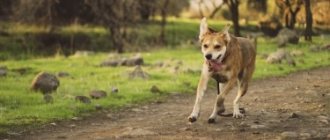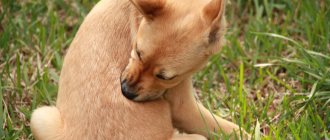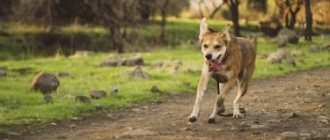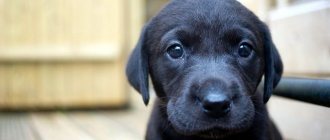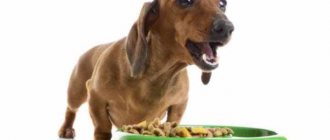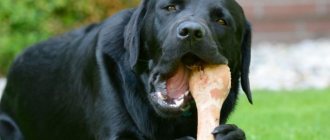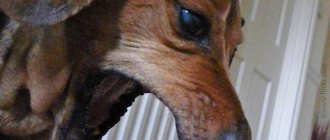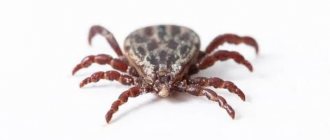Many dog owners sooner or later face the problem of a cracked or torn nail. This is very serious, because it means severe pain and discomfort for the pet. In addition, the wound may bleed.
If a person encounters such an incident for the first time, he may panic and provide incorrect assistance, which can subsequently lead to infection or improper growth of the claws .
Therefore, it is recommended that you familiarize yourself with the rules of first aid in advance, and also get a veterinary first aid kit if you don’t already have one.
Why is this happening?
A dog may catch its claw on carpet, upholstery, or protruding plant roots. She can also jump unsuccessfully, and the impact will cause her claw to bend and break. It is even easier to get damaged if the dog is already old. In this case, the claws become dry, brittle and brittle. The chance of injury is even higher if the animal's claws are long. These people are more likely to get caught and get injured.
Causes of nail injuries in dogs
There are many factors that cause injury:
- A sedentary lifestyle, as a result of which the pet does not grind down its claws naturally; they grow back and break off.
- You can damage a dog's claw when trimming it; if the procedure is carried out rarely, the inner layer (pulp) grows and with the next trimming it is very easy to hit the blood vessels. Painful sensations from such an injury are short-lived, treatment is carried out immediately, but the pet is left with an unpleasant memory of the manipulation and subsequent procedures are stressful.
- Walking in areas with uneven and traumatic surfaces.
- Animals of hunting “burrowing” breeds have a highly developed behavioral reflex of digging. If the surface that the pet decides to dig up is hard, the finger can easily be injured.
- Unbalanced diet. A lack of vitamins, macro- and microelements leads to the fact that the stratum corneum becomes excessively dry, loose and fragile.
- In winter, due to the layer of snow, the dog does not naturally wear off the stratum corneum on the asphalt (excessive regrowth and injury occurs).
- Violation of conditions of detention, especially in the enclosure type. Gaps in floors, stairs, and the presence of gratings that an animal can accidentally catch its finger on.
- Bathing a dog in bodies of water with poor visibility of the bottom surface.
- The development of an anatomical defect, the so-called “wolf claw”, is the presence of a dewclaw, fifth toe on the inside of the foot. On the front paw, such a rudiment is normal and has no function, but on the pelvic limb it is considered a deviation.
First aid
In the vet. The first aid kit must contain disinfectants (for example, hydrogen peroxide, iodine, brilliant green), hemostatic agents (a styptic pencil or regular baby powder; also, if they are unavailable, you can use flour) and painkillers (ibuprofen, naprocfen, aspirin).
For cracked claws
- rinse the wound with clean water;
- treat with peroxide;
- stop the bleeding.
There is nothing more you can do on your own, so after providing first aid, take your dog to the veterinarian !
ATTENTION : do not neglect a visit to the veterinarian, this can result in serious consequences - from infectious infection to amputation of the phalanx on which the claw is cracked!
If it breaks in half or a piece falls off
- rinse your paw with purified water - this is necessary to prevent dirt from getting into the wound, because it is important to prevent the development of pus;
- treat the wound with hydrogen peroxide ;
- further treat with brilliant green ;
- if there is blood after she breaks it, stop the bleeding using a bandage, gauze or towel as a pressure bandage;
- remove the part of the claw that has been damaged; it may interfere with the pet, cause discomfort or even pain;
- apply a swab with levomekol ointment and bandage the paw.
It is recommended to contact a veterinary clinic.
If you tore it out at the root
- wash the wound;
- treat with peroxide;
- stop the bleeding;
- tie a bandage on your paw to prevent infection;
- contact a veterinary clinic.
For any of these injuries, after first aid it is necessary to apply antibiotic ointment or powder to the root of the claw and bandage it with a bandage. Change such dressings about three times a day for a week or two.
If the dog has torn off the bandage and is constantly trying to lick the wound, then there are two options. The first is to put on a special cone for your pet, which does not allow the tongue to reach the wound. The second is to fasten the bandage around the neck, and put a thick sock on the paw, bandaging it with an elastic bandage.
ATTENTION ! When you give first aid to a dog that has damaged its nails, it is unlikely to sit still. Usually the pet breaks out, runs away, and sometimes even tries to bite the owner. No matter how kind a dog is, its behavior in times of severe pain can be unpredictable.
Be prepared for this course of events; during any procedure, especially one that causes discomfort and pain, hold your pet in a tight hug . This way he won’t be able to escape and, most importantly, he will feel safe.
Check out this video on how to stop a dog's nail from bleeding:
Types of root fractures
Dentists call several types of dental fractures:
- Transverse
(horizontal). The fracture is parallel to the cutting edge or chewing area. - Vertical
(longitudinal). Extent along the longitudinal axis of the crown. - Oblique
- a variant of the vertical one. The contour is at an angle to the tooth axis. - Splintered
. The presence of several fault lines.
The type of defect is visible in the picture. In the last two cases, removal is indicated, but in the first, there is a chance to restore the tooth.
Transverse fracture
The level of fracture and unit loosening varies. If the root of the tooth is broken in the apex area, then mobility is minimal. The intensity of the symptoms is determined by the damage to the pulp: when the integrity of the neurovascular bundle is damaged, sharp pain impulses will follow after pressing or biting. Is the fracture line in the middle of the root? The mobility is palpable.
Vertical root fracture
Such a tooth root fracture is difficult to diagnose in the early stages, but the clinic has advanced equipment that allows us to identify the defect. Previously, such a diagnosis was fatal, but in some episodes (for example, an incomplete fracture - a crack in the root of a tooth), restoration is possible with the help of special composite cements or innovative compositions. But in most cases, a longitudinal root fracture means that the tooth must be removed followed by implantation or other prosthetics.
How to avoid problems?
Caring for them should be a mandatory procedure. Trim your nails regularly to reduce the risk of breaking or breaking your nails. To do this, choose a nail clipper that suits your dog at the pet store.
The structure of a dog's claw is much more complex than that of many other animals and, even more so, than the structure of a human nail. Without going into details, you can divide it into the claw bed or, in other words, the pulp (inner layer) and the keratin sheath, which is located on the outside.
When cutting, it is very important not to touch the pulp, but to cut exactly the outer layer, parallel to the floor, so that the dog can walk comfortably.
If your pet's claws have no color , then it will be easy for you to determine the boundary of the layers, and therefore to carry out a quality trim. You can see the pulp by laying the dog on its back and looking at the inside of the paw.
If they are painted , then this border may not be visible, which complicates the process. Remember that only the keratinized tip of the claw should be cut off, being careful not to touch the soft tissue.
IMPORTANT ! If you do touch the pulp, treat the wound immediately. It is easy to notice the damage - the claw will begin to bleed, and the pet will struggle due to the pain caused.
You will have to practice for some time before the procedure begins to be carried out by you properly and is perceived calmly by the animal. Of course, if you are afraid of the sight of blood ( being inexperienced, you can touch the capillaries ), you are afraid of harming your pet by doing something wrong, then it would be best to contact a specialist.
Haircut frequency
It depends on the animal's lifestyle. If your dog constantly walks on hard surfaces, such as asphalt or paving stones, then the claws on his paws wear down on their own. All that remains is to ensure that there are always a few millimeters between them and the floor . If you have a dog that rarely walks on such surfaces, then the procedure should be carried out more often. The same can be said about the winter periods.
If proper and high-quality care for the claws is not provided, they can cause pain in the joints, because the claws interfere with the correct positioning of the paw , resulting in chronic diseases of the joints, injuries to the fingers and the claws themselves.
Remember that correcting these consequences will be hundreds of times more difficult than preventing them!
In addition to all of the above, it is imperative to take control of the dog’s nutrition. To strengthen the dog’s claws, as well as bones, fur and general condition, it is necessary to give it raw meat, bones, milk, and cottage cheese.
Instead of cottage cheese, it is not recommended to give glazed cheese curds , as many dog breeders do. You can replace fresh cottage cheese with hard cheeses or feta cheese. Be sure to include vitamins in her diet. Even with a completely balanced diet, you may still lack some vitamins.
IMPORTANT ! In the cases listed below, do not delay treatment and contact a veterinary clinic!
- The animal cannot step on its paw for more than an hour.
- Can't stop the bleeding.
- During processing, unpleasant discharge appears.
- If the dog whines a lot, it does not allow the wound to be treated.
- If the case is so serious that, obviously, surgery cannot be avoided.
Why do you need to remove the nail plate?
First of all, the fungus (onychomycosis) attacks the big toe. The reason is simple: the main part of the nail is often found in shoes. Bacteria that get on the plate begin to actively spread and cause harm. The nail may become curled and the finger may swell. Usually a person seeks medical help at this stage: unsuccessful self-medication leads to the neglect of the condition. When a fungus appears, the attending physician carries out therapy, prescribing various ointments and drops. They are designed to destroy the root of the disease. If the stage is late, then the medications cannot reach their target. Advanced cases require long-term therapy. Factors such as excessive sweating of the feet or certain features of shoes can complicate treatment. In order for drugs to access the source of infection, it is necessary to remove the affected area. This is the fastest way to get rid of onychomycosis. Removal of the plate is prescribed in the following cases:
- at least 70% of the nail is infected;
- the affected plate structure and finger swelling make it difficult to walk;
- the infection caused an ingrown nail;
- the root of the nail plate is infected;
- relapses.
Since the nail has a protective function, removing it completely is dangerous. This can provoke additional infection and cause severe discomfort during the recovery period. In some cases, only the top layer or a certain part of the nail plate requires removal. If previously the fungus was gotten rid of only with the help of medications or surgery, today more effective and painless methods have appeared.
Preventive actions
In order to worry less about why your dog’s nail has fallen off or broken, it is recommended to take certain preventive measures. Experienced dog breeders and veterinarians recommend that pet owners adhere to the following rules:
- Check and trim growing nails regularly. During growth, if you do not watch them, they can become twisted and prevent the animal from moving normally. In addition, they will constantly cling to everything when walking.
- For cutting, use only special dog scissors. Conventional ones disrupt the structure and lead to delamination. In addition, you can accidentally pull out a piece of nail from your finger.
- You only need to trim to a certain level. If you touch the vessels, blood begins to flow, and the dog becomes painful.
- It is imperative to monitor your dog’s diet so that it receives all the necessary elements and minerals.
Absolutely any dog is capable of tearing out or breaking a nail. Therefore, it is very important to monitor and care for your pet. It is also recommended to choose special, well-kept places for walking, where he will not encounter foreign objects or construction debris.
Nail prosthetics
After removing the nail plate, an unsightly crust remains. Women who are more demanding in matters of aesthetics suffer especially. The feeling of security in the legs disappears, which negatively affects the psychological state. Great discomfort is felt when walking.
To restore comfort during rehabilitation, you can use nail prosthetics - install an artificial plate made of acrylic or gel.
You cannot do prosthetics right away: it is necessary for the wound to close and a crust to form. There should be no inflammatory processes, suppuration, psoriasis or other problems. An artificial nail is placed only on a clean, healthy surface. Before the procedure, it is necessary to disinfect not only the feet, but also the instruments used.
- Gevol is a polymer mass that is placed in an empty bed. A nail is formed from it, and after hardening the plate is adjusted to its shape.
- Unigzan - suitable only in cases where part of the natural nail plate remains (at least 3 mm).
- Glue and canoline. Treatment will require a complex system of alternate application of glue and polymer composition. But the material is breathable, and the plate is thin.
- Acrylate - used to smooth the growth of healthy natural nails.
Do not confuse prosthetics and extensions. The procedure itself is similar, but the polymers used have different compositions. Plasticizers introduced into the prosthesis make the artificial nail flexible and durable. And special components treat fungus and protect against re-infection. Dentures are not suitable as the main antifungal agent. But they manage to prevent and maintain healthy feet.
